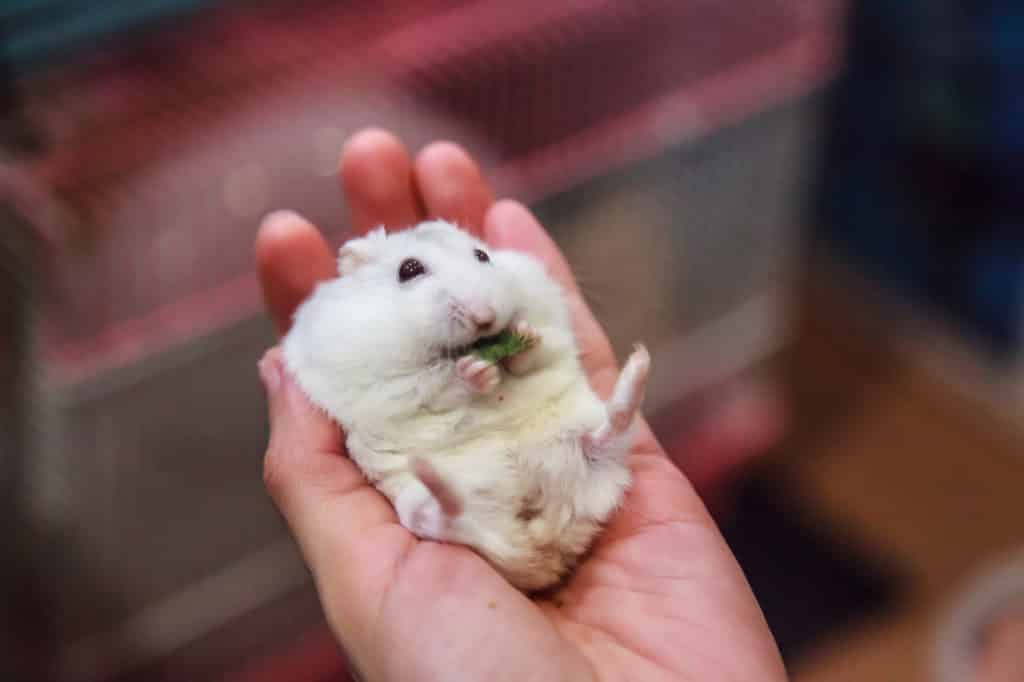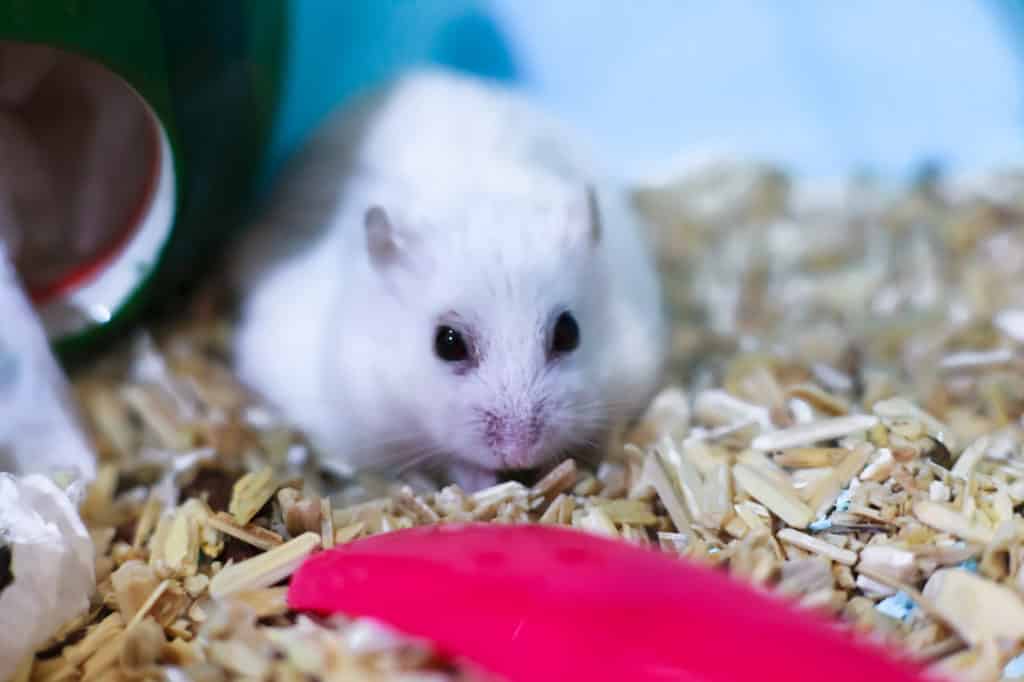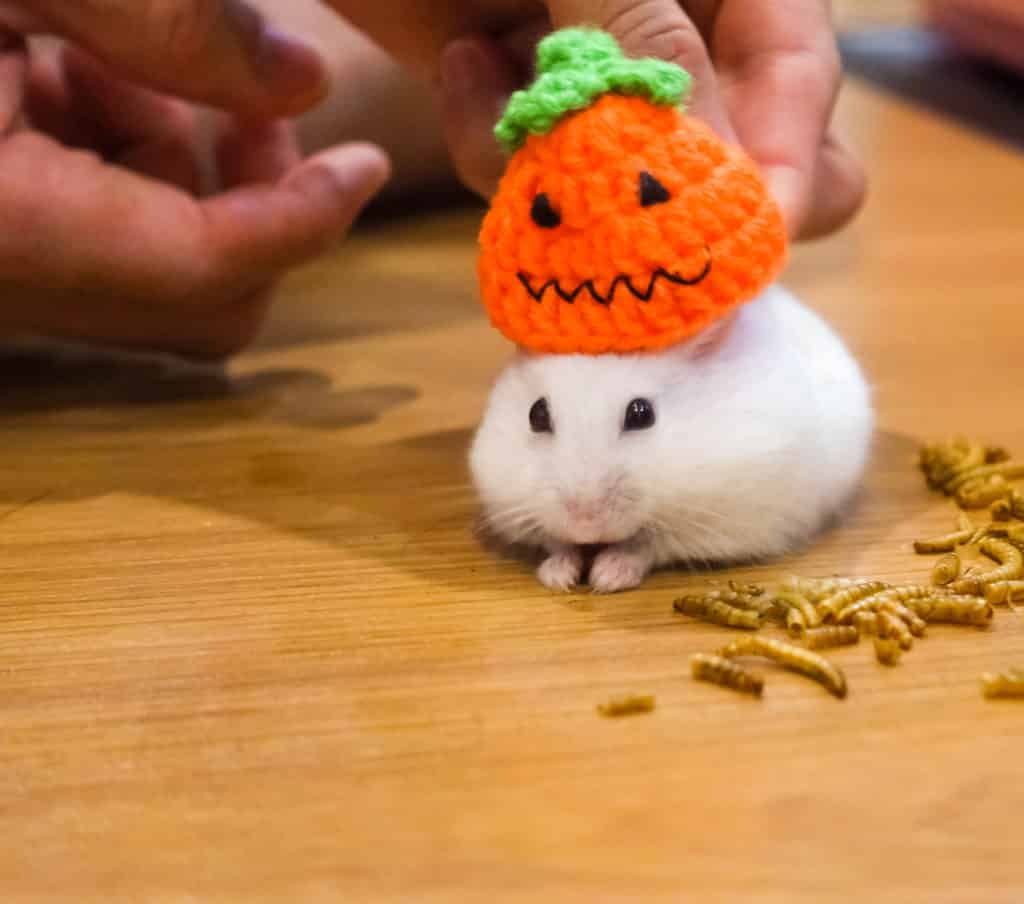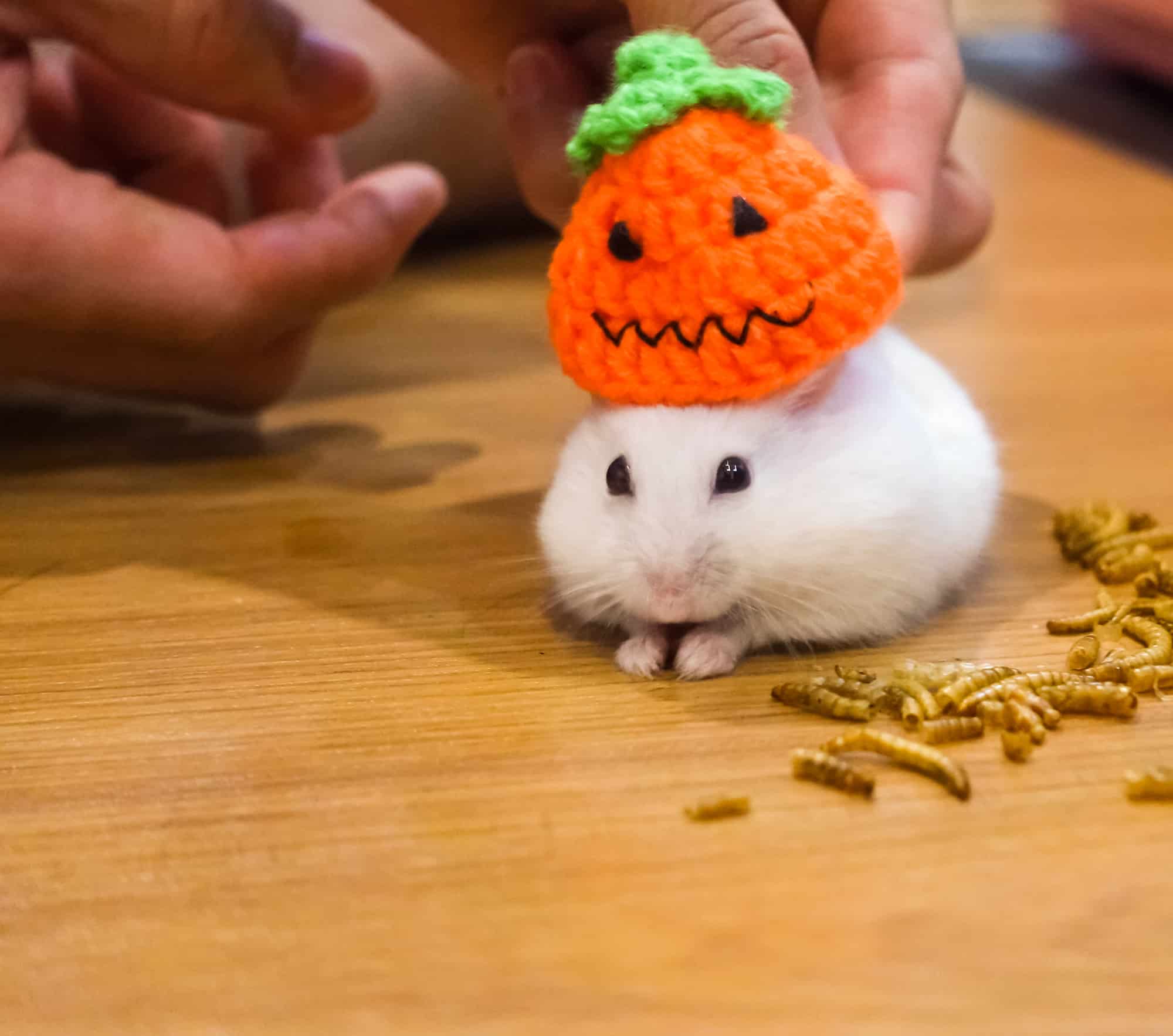Hamsters are not only small but also cute and easy to tame. So, in the past few decades, they have become one of the most common small pets around the world. But among the 19 different types of hamsters found on earth, only 5 species are kept as pets. One of these species is the Winter White dwarf hamster (Scientific name: Phodopus Sungorus).
The Winter White dwarf hamster goes by many names – Djungarian hamster, Siberian hamster, Siberian dwarf hamster, Russian hamster, Russian dwarf hamster, and Striped dwarf hamster.
The Winter White hamster is one of the three hamster species which fall under the genus Phodopus, whose members hail from Central Asia and portray extraordinary adaptation to extreme temperatures.
This blog post will help you find out everything you need to know about the Winter white dwarf hamsters, including their origin, appearance, and behavior. We will also look at how you can keep your pet Winter White hamster healthy and happy and what you can do to properly take care of him.
How does a Winter White hamster look?
Size
A Winter White hamster is a dwarf hamster; it is typically only half the size of a Syrian hamster. An adult Winter White hamster is normally 2 to 3 inches in length and weighs just an ounce. Male hamsters are generally larger than female hamsters (Source: BeChewy). Moreover, their scent glands are also more prominent than females.
Colors
In the wild, Winter White hamsters are available only in one color – greyish brown/black with a dark dorsal stripe. But as a result of breeding, three additional colors have emerged – sapphire (bluish-grey in color), pearl (white-colored fur, with the ends of the hairs in slightly different colors), and natural pearl.
Some pet shops might have Winter White hamsters in several additional colors as well. But it is important to know that these are hybrid hamsters (cross between Campbell and Winter White hamsters) and not pure Winter White hamsters at all. Even though these hybrid hamsters make good pets, they are known to have congenital health problems.
Features
Winter White hamsters are small creatures with fur on their feet and legs. It helps them survive the cold winters in the places where they live. Their bodies have a general round/oval-shaped appearance. They have round eyes, round ears, and a round face.
Besides these features, Winter White hamsters also have cheek pouches like other hamsters, which they use to carry food back to their burrows.
How to differentiate between a Winter White hamster and a Campbell hamster?
Winter White hamsters appear similar to Campbell hamsters. So, they were considered a subspecies of Campbell hamsters. But it has now been proven that the Winter White dwarf hamster is a separate species.
Even though the Winter White hamster and the Campbell hamster look similar, there are some differences between them:
- As explained above, Winter White hamsters appear rounder than Campbell hamsters. Moreover, they have wide, rounder faces, whereas the Campbell hamsters have long, thinner faces (Source: Animal fun facts).
- Moreover, Winter White hamsters have round ears and eyes. On the other hand, Campbell hamsters have ears that stand upright and eyes that are closer together.
- Winter White hamsters have smaller fur when compared to Campbell hamsters (Source: Animal fun facts).
- The Dorsal stripe of a Campbell hamster is narrower, darker, and shorter than that of a Winter White hamster.
- A Winter White hamster has white fur on its stomach. But a Campbell hamster has grey fur on its stomach.
- Finally, but most importantly, the fur of a Winter White hamster turns white as winter approaches (at least in the wild), but a Campbell’s fur doesn’t.
Why is a Winter White hamster called so?
There is a reason why the Winter White hamster is called so. This species of hamster normally has a thick, dark grey stripe and furry feet. But as days shorten due to the arrival of winter, the dark fur disappears, and white fur starts to appear. This helps them evade predators in the winter when the steppes are covered with snow (by creating a perfect camouflage).
However, this phenomenon cannot be observed in pet Winter White hamsters because they are often exposed only to artificial lights. So, their bodies cannot recognize the shortening of day-length.
Behavior
Social behavior
Winter White hamsters are social creatures. In the wild, they live in groups or colonies. So, you can put two or even a small group of Winter White hamsters together in the same cage.
But you should remember that in a cage, the conditions are quite different than in the wild. In the wild, two hamsters of opposite sexes live together, mate, and care for the pups. In the cage, however, it is recommended to keep two hamsters of the same sex together (which doesn’t normally happen in the wild) to avoid an unwanted litter.
Moreover, in the wild, if two hamsters fall out with one another, one of them can leave the burrow and find another place to live. But in a cage, where space is limited, it is not possible to get away from one another. This can often lead to squabbles. In addition to that, each hamster has its own personality. So, one of them can become aggressive and mean towards others.
But luckily, Winter White hamsters are vocal animals that can make high-pitched squeaks and squawks when they squabble with their cage mates or when they are frightened. So, you must always be on the lookout to make sure that they don’t become aggressive and start fighting one another. And never introduce a young hamster to an older hamster. It almost always leads to a fight.

Winter White hamsters are more tolerant than Campbell hamsters. Moreover, they are curious little creatures whose curiosity beats their fear of humans. So, they can come to your hands and explore you. Moreover, they can also quickly become friendly with you and start trusting you. So, they don’t bite humans as easily as Campbell hamsters. Therefore, they are suitable for being handled by adults and older teenagers.
But you should start taming them early on when they are still very young. Moreover, due to their small size, they need to be handled delicately. So, they are not suitable pets for small children and even for many first-time pet owners.
Diet
Winter White hamsters are found in Kazakhstan, Mongolia, Siberia, and Manchuria, in the steppes, and near wheat fields and meadows (Source: Wikipedia). In these regions, fruits and vegetables are scarce. So, since these hamsters have evolved to survive in their natural habitat, their digestive systems cannot handle sugars and acids found in many fruits and vegetables. If they eat sugary and acidic foods, they can suffer from diarrhea, obesity, and diabetes.
Hence, the variety of food items that a Winter White hamster can eat is very limited compared to a Syrian hamster. This is something you need to consider before buying a hamster.
But unlike Campbell hamsters, Winter White hamsters are not prone to diabetes. So, you have a little more freedom while choosing food items for a Winter White hamster when compared to a Campbell hamster.
The diet of your Winter White hamster should definitely contain safe hamster food like commercially available hamster pellets. But they shouldn’t be the only food item you give your hamster. You should provide a balanced diet to your Winter White hamster. In the wild, Winter White hamsters eat seeds, nuts, plants, and some insects. So, the diet of a pet hamster should also be somewhat similar.
Therefore, to create a balanced diet, you can mix hamster pellets with food items like nuts (cashews, walnuts, peanuts), seeds (sunflower, pumpkin, sesame), vegetables (basil, bell pepper, green beans, asparagus, cucumber), meat, and other animal protein (cooked meat like chicken, egg white and insects like crickets, grasshoppers), oats, and barley (Source: Squeaks and Nibbles).
Even though greens and other water- and fiber-rich vegetables are healthy for your hamster, keep them to a minimum as they can cause digestive problems, including diarrhea. Fruits and vegetables that contain sugars should also be kept at a bare minimum to avoid your Winter White dwarf hamster getting diabetes.
Sleeping habits
Winter White hamsters are nocturnal creatures. They are mostly active during the night (Source: The spruce pets). They may be active during the day only for short durations.
Winter White hamsters can squeak a lot when they are active (Source: National Hamster Council, UK). Moreover, their movement, like running in the hamster ball, can be heard if you’re nearby. So, if you are a light sleeper, don’t place your hamster’s cage near your bed because their nighttime activity could wake you up. This is also something you need to consider before buying a pet.
But even though Winter White hamsters are nocturnal creatures, they can be made to sleep at night by providing treats and attention to them during the day. This, however, can affect the health of your Winter White hamsters since they have evolved to be nocturnal creatures.
Keeping a Winter White hamster as a pet – Hamster Care
Winter White hamsters are the most tameable species of hamsters. But they also have the shortest lifespan among all the species of pet hamsters. In the wild, despite the camouflaging ability nature has provided them, they don’t even live for a year. Indeed, many of them don’t even survive for six months.
But in captivity, they can live for 1.5 to 2.5 years when cared for properly. So, if a long-term commitment scares you, a Winter White hamster might be the right choice for you. Just like Syrian and Campbell hamsters, the right temperature for a Winter White hamster is 18°C to 24°C.
Winter White hamsters need a similar sized cage as Campbell hamsters, i.e., at least a floor space of 434 sq. inches and a height of 12 inches. You should also keep some hamster toys, like a hamster wheel, ball, chew toys, etc. The wheel (and ball) should be of the right size – at least 5″ in diameter, so that your hamster can run in it without arching its back and damaging its backbone (Source: Petsvills).
Winter White hamsters are clean animals who like to clean themselves a lot. So, you should also have a sand bath in your hamster’s cage, so that he can clean himself as often as he wants.
In the wild, Winter White hamsters live in tunnels located one meter under the ground. This helps them protect themselves from the extreme temperatures above the ground and escape from predators like owls, foxes, etc.
These underground tunnels have many entrances. But when winter comes, Winter White hamsters block all but one entrance (to prevent cold air from entering the tunnels) and line their burrows with fur or animal wool so as to keep themselves warm. So, simply put, Winter White hamsters like to burrow a lot. Therefore, you should provide them ample soft bedding for them to burrow into.
The absolute minimum amount of bedding needed for a Winter White dwarf hamster is 4 inches (depth) of bedding. However, if you have a wooden hamster cage, then the bedding should at least be 12 inches deep so that your hamster’s urine doesn’t soak into the floor of the cage and create a permanent stench. The best types of beddings to use are shredded paper and wood shavings.

When it comes to dwarf hamsters, it is better not to buy a wire mesh cage as they can easily squeeze through the openings, fall down, and hurt themselves. But if you really want to choose a wire cage, you should be mindful of the gap between the bars.
Lifecycle of a Winter White hamster
Most hamster species are polygynandrous, i.e., both the male and the female can have multiple partners. Once a male and a female mate, the pups will be born in 18 to 25 days (Source: Midland Hamster Club, UK).
The average litter size is 4 to 10 pups. Compared to Syrian hamsters, Winter White hamsters reproduce at a faster rate. After all, this species has a low survival rate. So, the only way for the species to survive in nature is to produce more offspring. Therefore, they reproduce at a faster rate when compared to other bigger species of hamsters.
The pups reach sexual maturity when they are 5 weeks old, but they don’t become full adults until they are three months old. But the time when they attain sexual maturity is when you should separate the opposite genders. If not, inbreeding can occur and produce unwanted pups.
Diseases and medical conditions
Winter White dwarf hamsters aren’t especially prone to any diseases. But they are susceptible to diseases that other hamster breeds are prone to.
- Diarrhea: Diarrhea is a condition that can affect many pet hamsters. In the wild, many species of hamsters live in regions where access to fresh fruits, vegetables, and water is limited. Even though this leads to malnutrition that reduces the life expectancy of hamsters, many breeds have evolved to survive in these conditions. So, providing vegetables and fruits rich in water, sugar, and/or fiber can cause diarrhea. And unlike human beings, diarrhea can be deadly for hamsters because it can cause Wet Tail, which can suddenly cause death. Symptoms of this deadly condition include dehydration, loss of appetite, and a wet tail with pieces of feces sticking to it.
- Mite & other skin infections: Most pet hamster species have fur. So, they are prone to mite infections. If your pet hamster is suffering from mite infestation, he might often scratch his fur since his skin will feel itchy. This will make him lose his fur, causing bald patches to appear on his coat. A wrong choice of bedding might also cause allergy and skin infections for your hamster.
- Abscess: An Abscess is a condition where the area under the skin gets infected and filled with pus. This happens mainly as a result of cuts to the skin. As a result of such a cut, the area under the skin becomes infected, and pus starts to accumulate there. As more and more pus accumulates, the skin in that area becomes swollen and looks like a lump. Cheek pouches are one of the hamster body parts prone to Abscess. Sharp food items like the edges of nuts and seeds can injure the cheek pouches and create an Abscess. If your hamster’s cheek pouch appears as if it’s loaded with food all the time, it could actually be an Abscess. If your hamster has an Abscess, you should take him to a veterinary doctor, who can drain the pus.
- Scent gland tumor: Hamsters have scent glands on various parts of their bodies. Scent glands are essential to the survival of a hamster. But they are also prone to tumors. If your hamster’s scent glands look greasy or discolored, you don’t have anything to worry about since that is how scent glands normally look. But if their color changes, or if they suddenly become swollen, it might be a tumor.
- Teeth problems: A hamster’s teeth constantly grow until he dies. So, they must be worn out regularly. Several toys available in pet stores can help a hamster wear his teeth out. If a hamster’s teeth don’t wear out, it could lead to an Abscess. Even worse, it could grow into his nasal cavity. Overgrown teeth might also prevent your hamster from eating properly and thereby cause malnutrition. As a result, your hamster could lose weight. So, if your hamster’s teeth don’t wear out, you should take him to a vet, who can cut them.
- Diabetes: Besides the above problems, some hamster species are also prone to diabetes. Even though Winter Whites aren’t prone to diabetes as much as Campbell hamsters, it is still advisable to not give them too much of sugary food items (including fruits and vegetables with high sugar content).
If your hamster suffers from any of the health problems mentioned above, you should take him to a veterinary doctor. You should take your hamster for regular medical check-ups as well.



